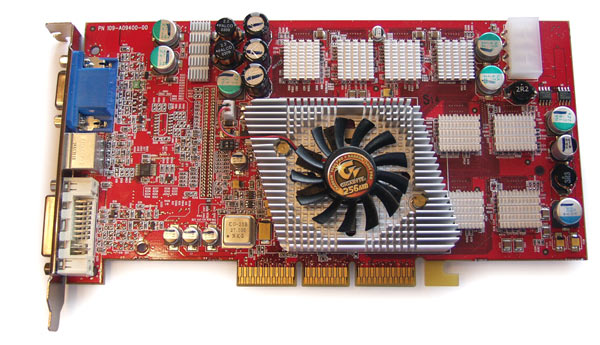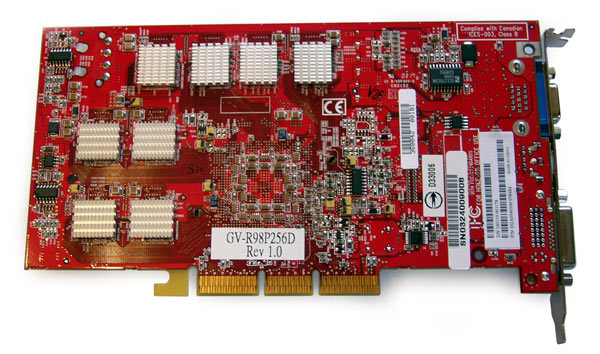A Roundup of ATI Radeon 9800 PRO video cards
Gigabyte GV-98256D based on the Radeon 9800PRO 256MB DDRII
| Gigabyte GV-98256D 256MB |
| GPU |
ATI RADEON 9800 PRO |
| Memory (Max) |
256 MB DDR-II SDRAM 2.2 ns |
| Memory/processor clock speed |
380/350(700) MHz |
| RAMDAC Frequency |
400 MHz |
| API |
OpenGL, DirectX, Direct3D |
| Support for two monitors |
Yes |
| Video Output |
2048 x 1536 / 60 Hz - 24-bit (16.7M colors) |
| Interface |
AGP 8X |
| Ports and connector type |
1 x DVI-Analogue Digital - 29 pin DVI
1 x VGA - 15 pin HD D-Sub (HD-15)
1 x S-video output |
| Maximum resolution |
2048x1536 / 60 Hz |
Like all the previously reviewed, this card is made on a red PCB. The main distinction of this board from the Radeon 9800 PRO 128MB is in the doubled capacity of onboard memory as well as in the use of DDR-II memory. This certainly has resulted in essential remake of the PCB - the number of chips has doubled and they are now positioned in an entirely different way - 4 chips on top and 4 chips sideways on each side of the board. There are 16 DDR-II memory chips onboard altogether, each cooled with a small needle-type radiator. That is a forced move, since the DDR-II memory chip heats up immensely at work, and even with the installed radiators the temperature of the chips is very high - you won't hold a finger on the radiator's chip longer than 10 seconds!
 Gigabyte GV-98256D front; *1200x960 221 kb
Gigabyte GV-98256D front; *1200x960 221 kb
 Gigabyte GV-98256D back; *1200x707 222 kb
Gigabyte GV-98256D back; *1200x707 222 kb
The chips themselves are made by Samsung and offer 2.2 ns access time, which is equivalent to 454(908) MHz. The rated memory frequency is 350(700) MHz.
Frankly, it's not quite clear what sense was in repeating NVIDIA's mistake in using the DDR-II memory, very sensitive to inductions. While NVIDIA gave up using the GDDR-II, ATI is still equipping its boards with memory of this type even though using the DDR-II does not give any essential performance boost as compared to the regular DDR. But, as the proverb says, come and have pot-luck with us :)
The cooler on the Gigabyte board is precisely the same as on the reference card, it differs only with a sticker but in fact it proved to run quieter than the "reference".
One of the memory chips is positioned too close to the board's cooler, that is why the radiator's edge was cut off. Cutting off the radiator does not deteriorate cooling of the chip at all, since there is a GPU cooler nearby, and air flows dispersed by the fan will hit the adjoining memory radiators as well. So there is no reason to worry about the stability.
In fact, there is nothing else the card stands out with, so let's move on to exploring the package bundle, which is worth it fortunately.
Let's start with the package. The card is packaged in a nice-looking box whose front wall opens up like a book. On opening the "book" you can see a list of the board's main features, some "vs. Radeon 9700 PRO benchmarking" diagram as well as a photo of the card with a visual enumeration of its components and options. The video card shown on the photo does not slightly match that put into the package - that is a 128 MB version of the Radeon 9800 PRO, but it's really nice anyway. Perhaps Gigabyte made such a package design to allow the buyer make himself aware of the main options of the card already on the way home :) I can imagine someone in the subway holding the open book with a Radeon 9800 PRO inside ...
Opening the box and remove ...
- the card itself :)
- Drivers CD and Gigabyte's own V-tuner tweaking software
- S-Video extension cord with an RCA ramification
- Additional power cable with a brancher
- DVI -> D-Sub adapter
- The user's manual is made in multiple languages except Russian.
- Licensed version of the PowerDVD XP 4.0 software.
The bundled games merit a special mention. So the card comes bundled with licensed versions of the following games:
- Serious Sam The First Encounter
- Motocross Mania
- Heavy Metal - F.A.K.K.
There are also demo versions of 4X4 Evolution and ONI on a separate CD.
Well, this card is definitely worth taking to a LAN Party :)
Gigabyte V-Tuner
For overclocking its video card, Gigabyte offers its own utility - V-Tuner. The utility offers a simply and smart GUI - there are two sliders sideways of the window, with the first used for overclocking the chip and the other for overclocking the card's memory. In the middle, there are two speed meters showing the current frequency values. Under each of the slider there are four buttons: Go (apply settings), Default , Load and Save (revert to the previously taken frequency and save the current frequency value). The GUI of V-Tuner is intuitive, and even a rookie will handle it easily.
Overclocking and impressions
The video card's chip showed a pretty good overclocking result - 440MHz, with the memory results lagging behind a bit. Actually, you can't expect more from the DDR-II memory in view of its excessive sensitivity and high heat emission level.
All in all, the card left a very good impression - an excellent product, a very fast and well-made video card, with the package bundle up to the mark either. It's simply a pleasure holding such a video card on hands, and a real enjoyment trying it in action :)
 |
Content: |
 |
|
 |
Top Stories: |
 |
 |
 |
MoBo:


|
 |
 |
 |
VGA Card:


|
 |
 |
 |
CPU & Memory:

|
|
|
